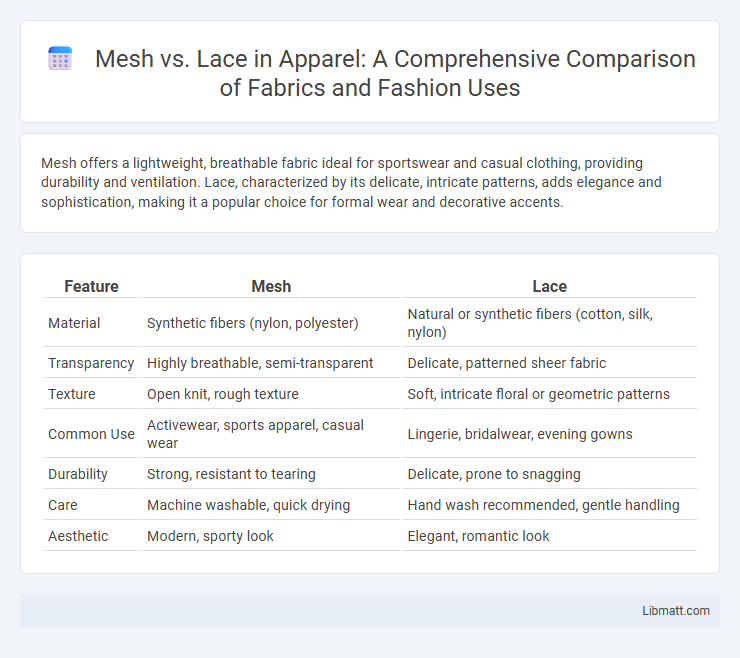Mesh offers a lightweight, breathable fabric ideal for sportswear and casual clothing, providing durability and ventilation. Lace, characterized by its delicate, intricate patterns, adds elegance and sophistication, making it a popular choice for formal wear and decorative accents.
Table of Comparison
| Feature | Mesh | Lace |
|---|---|---|
| Material | Synthetic fibers (nylon, polyester) | Natural or synthetic fibers (cotton, silk, nylon) |
| Transparency | Highly breathable, semi-transparent | Delicate, patterned sheer fabric |
| Texture | Open knit, rough texture | Soft, intricate floral or geometric patterns |
| Common Use | Activewear, sports apparel, casual wear | Lingerie, bridalwear, evening gowns |
| Durability | Strong, resistant to tearing | Delicate, prone to snagging |
| Care | Machine washable, quick drying | Hand wash recommended, gentle handling |
| Aesthetic | Modern, sporty look | Elegant, romantic look |
Introduction to Mesh and Lace
Mesh and lace are lightweight fabrics often used in fashion and home decor, each offering unique textures and visual appeal. Mesh features an open, net-like structure that provides breathability and a modern aesthetic, while lace is characterized by intricate patterns created through looping threads, delivering a delicate and elegant look. Your choice between mesh and lace depends on the desired style and functionality for your project.
Defining Mesh: Characteristics and Uses
Mesh fabric features an open, net-like weave that allows for high breathability and lightweight comfort, making it ideal for athletic wear, outdoor gear, and bags. Its durability and flexibility provide excellent ventilation without sacrificing strength, widely used in sports jerseys and orthopedic supports. The porous nature of mesh enhances moisture-wicking properties, ensuring quick drying and optimal performance in activewear and industrial applications.
Understanding Lace: Features and Applications
Lace is a delicate fabric characterized by intricate openwork patterns created through looping, twisting, or knitting threads, often made from cotton, silk, or synthetic fibers. It is commonly used in fashion for elegant garments, bridal wear, lingerie, and decorative trims due to its aesthetic appeal and lightweight texture. Understanding lace's detailed craftsmanship and versatile applications helps you choose the right fabric for sophisticated and ornamental designs.
Mesh vs Lace: Key Visual Differences
Mesh fabric features an open, net-like structure with uniform holes, offering a sportier and more breathable appearance. Lace displays intricate, floral or geometric patterns with delicate, interwoven threads that create a more elegant and ornamental look. The key visual difference lies in mesh's simplicity and functionality contrasted with lace's detailed, decorative design.
Texture and Feel: Mesh Compared to Lace
Mesh fabric features an open, airy texture with a slightly coarse feel, providing excellent breathability and durability ideal for activewear and sports garments. Lace offers a delicate, intricate texture with a soft, smooth touch that emphasizes elegance and femininity, often used in lingerie and formal wear. The tactile experience of mesh is more utilitarian and structured, whereas lace delivers a lightweight, decorative softness.
Durability and Maintenance
Mesh fabric offers higher durability due to its tightly woven synthetic fibers, making it resistant to tears and stretching, while lace, often made from delicate threads like cotton or silk, requires gentle handling to maintain its intricate patterns. Cleaning mesh typically involves simple machine washing with minimal risk of damage, whereas lace demands careful hand washing or the use of a protective laundry bag to prevent fraying and distortion. The maintenance of mesh is low-effort and suited for everyday wear, contrasting with lace's need for meticulous care to preserve its aesthetic and structural integrity.
Style and Aesthetics: Fashion Preferences
Mesh offers a sporty, edgy appeal with its open-weave structure that enhances breathability and creates bold texture contrasts in garments. Lace delivers a delicate, intricate aesthetic characterized by floral patterns and fine detailing that evoke elegance and femininity. Fashion preferences between mesh and lace often depend on desired mood, with mesh favored for modern, casual looks and lace chosen for classic, romantic styles.
Breathability and Comfort
Mesh fabric offers superior breathability compared to lace, featuring an open weave that allows optimal airflow to keep your skin cool and dry. Lace, while often more decorative and delicate, tends to trap heat and moisture due to its tighter knit structure, resulting in less ventilation. For maximum comfort during extended wear, mesh is the preferred choice because it promotes ventilation and reduces sweat buildup.
Popular Products: Where Mesh and Lace Excel
Mesh excels in popular products like athletic wear and casual apparel due to its breathability and durability, making it ideal for active lifestyles. Lace dominates in elegant lingerie, bridal gowns, and high-fashion garments where intricate patterns and delicate textures enhance aesthetic appeal. Your choice between mesh and lace depends on whether you prioritize comfort and ventilation or ornamental design and sophistication.
Choosing Between Mesh and Lace: Factors to Consider
When choosing between mesh and lace, consider breathability, durability, and aesthetic appeal to match your garment's purpose. Mesh offers superior ventilation and durability, ideal for activewear or sportswear, while lace provides intricate detail and elegance perfect for formal or intimate apparel. Evaluate the intended use, comfort preferences, and design requirements to make the best fabric choice.
mesh vs lace Infographic

 libmatt.com
libmatt.com